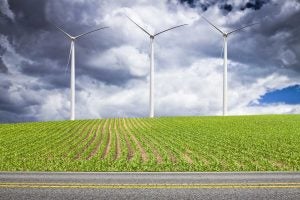Wind turbines. Some people love ‘em, some people hate ’em. Environmentalists love them, so do people who rent land to energy companies and receive a regular check. People who live close without a paycheck, and who have their viewshed filled with towering machines — not so much love.
But wind energy keeps growing. CNBC business news reported in February that “Wind has become the ‘most used’ source of renewable electricity generation in the US.” The U.S. Energy Information Administration reports wind capacity totaled 103 gigawatts (billion watts) at the end of 2019. Generation from those windmills reached 300 million megawatt hours (one megawatt hour is one million watts for one hour), 26 million more than hydro production. Over the next few years the industry is expected to invest $62 billion or more into new projects.
But all this investment comes at considerable cost to taxpayers. For the first 10 years of production, wind energy producers get paid federal production tax credit (PTC) worth $23 for each megawatt-hour they produce. In some markets, that subsidy can exceed the wholesale price of electricity. When subsidies, grants, and tax credits given by states are added to the federal subsidies, turbines can sometimes be installed and operated nearly free. Warren Buffett, whose companies build and operate wind farms, has said, “We get a tax credit if we build a lot of wind farms. That’s the reason we build them. They don’t make sense without the tax credit.”
The average house uses about one kilowatt (1000 watts) of electrical energy every hour. A 1000 megawatt (million watt) dam is said to power one million homes. A 1000 megawatt wind farm, on the other hand, is said to power 300,000 homes, because the wind, on average, only blows 30 percent of the time. A more accurate statement would be to say it powers one million homes 30 percent of the time. The other 70 percent of the time, hydro, fossil fuel, or nuclear is supplying the power. When Amazon, or Facebook, or any other company says they buy all “green power,” that’s not what they get. When the wind farm they bought the power from is idle, they get whatever the grid is supplying, and the wind farm buys grid power to meet its obligations.
Before wind turbines, Northwest dams provided 98 percent of needed power for Northwest homes and industry.
“Only about 15% of the wind power in the [Columbia] Gorge is used locally, the rest is shipped south,” Gretchen Bakke said in her book, The Grid. “The high voltage DC line that carries electricity from the Gorge has a capacity of 3100 megawatts, half of L.A.s peak capacity. When the wind is blowing hard, this line won’t carry it. May 19, 2010. 1000 windmills were lazily spinning on the Columbia Rim Gorge. In an hour, they were at full throttle as a storm rolled out of the East. Suddenly almost two nuclear plants worth of power was added to the grid—the largest spike the Northwest had ever experienced…in May the dams are at capacity. Spilling water was the only option. And that option kills fingerling salmon. … The balanced power system in the Northwest that has taken a century to build is now out of kilter because of wind and solar.”
Wind now provides about 7 percent of the electrical energy in the Northwest. That is not an increase in renewable power because it only subtracts from hydro. Fossil fuel and nuclear stay the same because they cannot ramp up and down rapidly to compensate for wind generation. Some years, spring runoff is so great dams can’t curtail production and still meet spill requirements for salmon. In 2011 Bonneville Power Administration (BPA) had to cut off coal, natural gas, and wind generators to prevent overloading the grid. Federal power was supplied to them for free to serve their customers. That was OK for fossil fuel users, but wind generators were unhappy because they lost kilowatt-hour production subsidies from Uncle Sam. So they went to court, and when reductions were mandated again in 2012, BPA paid renewable producers $2.7 million for 47,000 megawatts of power not produced. You can see the problem with Northwest wind: It blows in the spring when hydro is abundant, and is often idle during summer heat and winter cold.
Nevertheless, we have it, and I decided to check the nuts and bolts of winds farms near me. Some of my friends say they produce no usable power because the wind is too slow and infrequent. Wind farms also use power from the grid when the wind is not blowing, and some say they never break even on power used vs. power produced. My clue that this was important is the fact that for at least three Public Utility Districts in nearby counties with wind farms, the farms are their biggest customers. But getting exact information on grid use by wind farms proved elusive. Turbine manufactures and wind farm operators don’t know or don’t want to release that information. One study from the University of Minnesota concluded grid consumption was about 50 kilowatts for a Vestas V82 1.65 megawatts turbine, or about 8.3 percent of its reported production.

Puget Sound Energy has a wind farm, Hopkins Ridge, in Columbia County, Washington, and an office in Dayton. So I sent them a long list of questions. The farm consists of 87 turbines, with a total nameplate capacity of 156.7 megawatts. Their website claims an annual output of 404,000 megawatt hours, or 29.4 percent of nameplate capacity. That seemed high to me, considering all that I had heard about low wind speeds and idle machines from residents. So I challenged that figure. The comeback was, “During the period 2006-2018, Hopkins Ridge generated 179 times more power than was consumed as station (grid) power.” So whatever the grid use is, it seems insignificant compared to power produced. It should be noted that all generating facilities use grid power when not generating, to run lights, heating and cooling, computers, etc.
At Hopkins Ridge, the turbine generators turn on a ratio of 111 to 1, meaning at the governed blade speed of 16 rpm, the generator is at full capacity — 1800 rpm. What wind speed is required for full production? Recently I went to Hopkins Ridge with a stopwatch to measure turbine speed. Surface wind speed was about 15 mph. Most turbines were turning at maximum, 16 rpm. Blade speed is governed by pitching the blades according to wind speed. Grid power is used to pitch the blades and power the magnetic field of the generator.
Presently there are 4714 wind turbines installed in the states of Washington, Oregon, Idaho, and Montana, with a nameplate capacity of 8281 megawatts. These overwhelm the grid at times, but when they are most needed — late summer, fall, foggy and cold winters — they often stand silent. Too much power when we don’t need it; no help when water supplies run low. In my opinion we should stop installing them and shift subsidies to grid improvements and power storage projects.
Jack DeWitt is a farmer-agronomist with farming experience that spans the decades since the end of horse farming to the age of GPS and precision farming. He recounts all and predicts how we can have a future world with abundant food in his book “World Food Unlimited.” A version of this article was republished from Agri-Times Northwest with permission.



